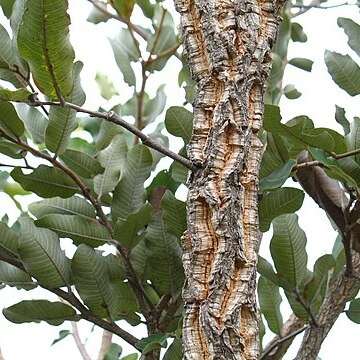Trees or shrubs, sometimes low and rhizomatous. Leaves simple, entire, with 2 glands on the upper side of the petiole or at the junction of the petiole with the blade. Bracts, bracteoles, and stipules caducous. Flowers hermaphrodite. Calyx-tube turbinate and often obliquely bent (subgen. Sarcostegia) or cup-shaped and unilaterally gibbous or ± so (subgen. Parinari); calyx-lobes 5, triangular-acute (Parinari) or ± rounded, concave (Sarcostegia). Petals 5, caducous. Fertile stamens very many (20–40), long-exserted (Sarcostegia) or few, 7–8, not or scarcely exserted (Parinari), confined to the dorsal and lateral rims of the strongly concave receptacle, and replaced at the frontal rim by very short staminodes. Ovary dorsifixed; carpels usually 1, rarely 2–3, each bilocular (sometimes only partially so); ovules 1 to each cell; style basal, long-exserted (Sarcostegia) or short, included or ± so (Parinari). Fruit drupaceous, ellipsoid, obovoid or ± globose, 1-seeded.
Drupe fleshy; epicarp verrucose; endocarp hard, thick, with a rough, fibrous surface, with 2 basal plugs or stoppers, the detachment of which allows the seedlings to escape.
Stamens 6–10; filaments white, slightly curved in bud and during anthesis, slightly expanded at the base; staminodes c. 6, subulate.
Lower leaf-surface with a close, prominent, reticulate venation which delimits small stomatal cavities (crypts) filled with hairs.
Ovary monocarpellary, 2-locular, inserted in upper half of receptacle-tube below the mouth; style arcuate, included.
Bracts and bracteoles eglandular, completely concealing flower buds, both individually and in small groups.
Receptacle-tube subcampanulate, slightly swollen on one side, hairy inside throughout.
Inflorescence a many-flowered complex cyme or cymose panicle.
Germination hypogeal, first leaves alternate.
Trees or rhizomatous geoxylic suffrutices.
Petals as long as sepals, caducous.
Flowers slightly zygomorphic.
Sepals acute.
Pending.

